
CLUB WORLD CUP SEMI FINAL, JULY 9 2025
Ruiz (6, 24)
Dembélé (9)
Ramos (87)
European champions Paris Saint-Germain progressed to the Club World Cup final with this statement thrashing of Real Madrid. Luis Enrique’s team will face Conference League winners Chelsea next at the MetLife Stadium, as they seek to win a fifth competition out of five in an elongated 2024/25 season. For Xabi Alonso and Real Madrid, meanwhile, the soul-searching begins as they seek to challenge PSG on the continental stage next season.
Played in the sweltering New Jersey summer heat, this heavyweight clash was practically over as a contest in under 25 minutes, with PSG going three up. Fabián Ruiz punished a big mistake by Raúl Asencio to open the scoring, before Ousmane Dembélé doubled the lead before 10 minutes were up. Ruiz then added the killer third after good play between Achraf Hakimi and Dembele. From there PSG were rarely troubled, leaving Gonçalo Ramos to add gloss to the result with a late fourth.
Below, our UEFA-licensed coaches explain the tactical highlights from this Club World Cup semi final…
How the managers saw it
“We started the game very good and we’re very happy with the performance,” said Luis Enrique. “Especially in those conditions. It’s too much heat for me. You need to play in different conditions to watch a better show. But both teams did it great. And we are having a special season and deserve to win.”
“The start of the match had a big impact for us,” said Alonso. “We wanted a well-managed start, knowing we were up against a very strong opponent. By the 10th minute, the game had already become very difficult for us, and that’s a sign that we still have a lot of work to do. Conceding two early goals demands a lot more from you – you know you can’t lose your balance because they have a very high level.”
 125452178871071418352220141553079
125452178871071418352220141553079Advancing Hakimi
PSG’s dominant first half stemmed from how they used their full-backs. From their initial 4-3-3 shape, they exploited spaces on the outside of Madrid’s narrow midfield – the Spanish side operating a 4-3-3 themselves when defending. Right-back Hakimi moved forward as often as possible, with Dembélé, Désiré Doué and João Neves rotating and combining superbly in the right inside channel. Ruiz, as the left number eight, made runs to penetrate the box (below), and profited from Dembélé’s counter-pressing for the opening goal.
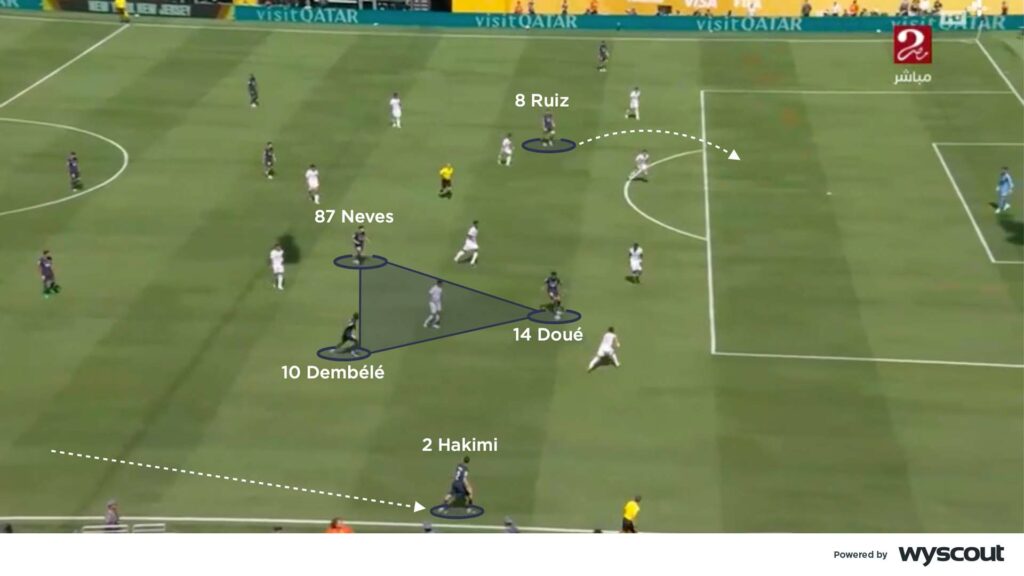
PSG’s numbers in the right inside channel helped them to progress the ball, especially with Hakimi often drawing Madrid’s left-back out for others to exploit. When they lost the ball, PSG had numbers to counter-press, making it very difficult for Madrid to build any sort of passing momentum. As a result, Madrid were often limited to isolated counter-attacks, which PSG’s back line dealt with. Dembélé robbed Rüdiger to add a second, while Hakimi’s forward running and passing provided another for Ruiz, as PSG raced into an unassailable lead.
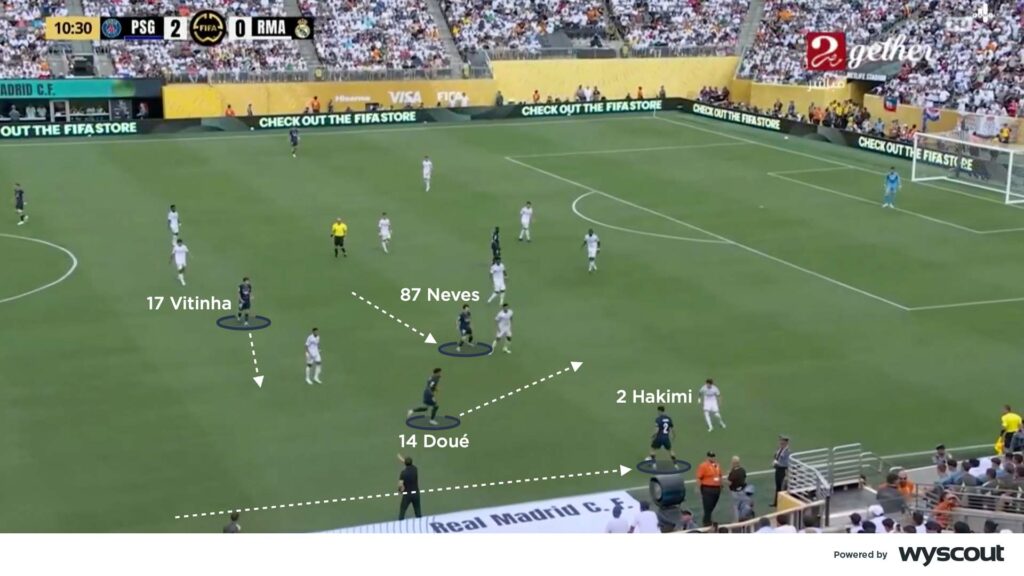
Rotating Mendes
Left-back Nuno Mendes’ forward running and the rotations around him helped PSG to progress the play on his side, mostly after they’d gone three up. PSG’s converted back three continued to build from the back, but with Mendes higher, Ruiz sometimes dropped in alongside centre-backs Lucas Beraldo and Marquinhos. Mendes could then receive higher and attack with left-winger Khvicha Kvaratskhelia, who held the width on this side almost exclusively. Madrid’s central midfield, meanwhile, still struggled to defend across the pitch (below).
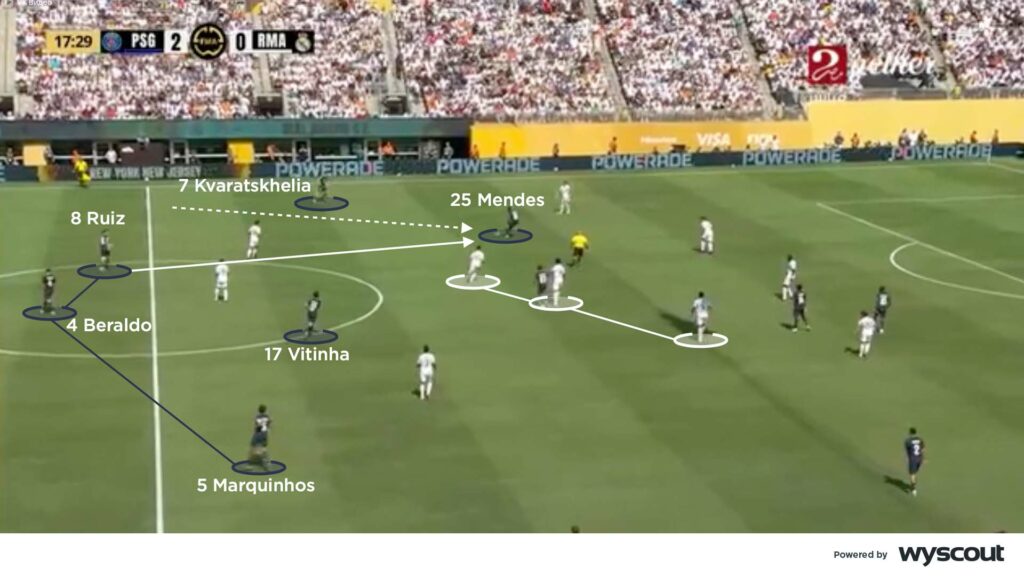
Single pivot Vitinha also dropped into the back line to allow Mendes to reposition higher, with Ruiz moving central to become the main pivot. Kvaratskhelia’s height and width on the left pinned Madrid’s right-back Federico Valverde, freeing Mendes to receive higher. Madrid’s front three pressed player-for-player on PSG’s converted back line, but were unconvincing and allowed access into Mendes far too easily. Meanwhile, Madrid’s midfield struggled to cover these passes around. Although PSG attacked with fewer numbers on the left, they still posed a threat as Mendes drove with the ball, ran forward off it or repositioned higher (below), to great effect.
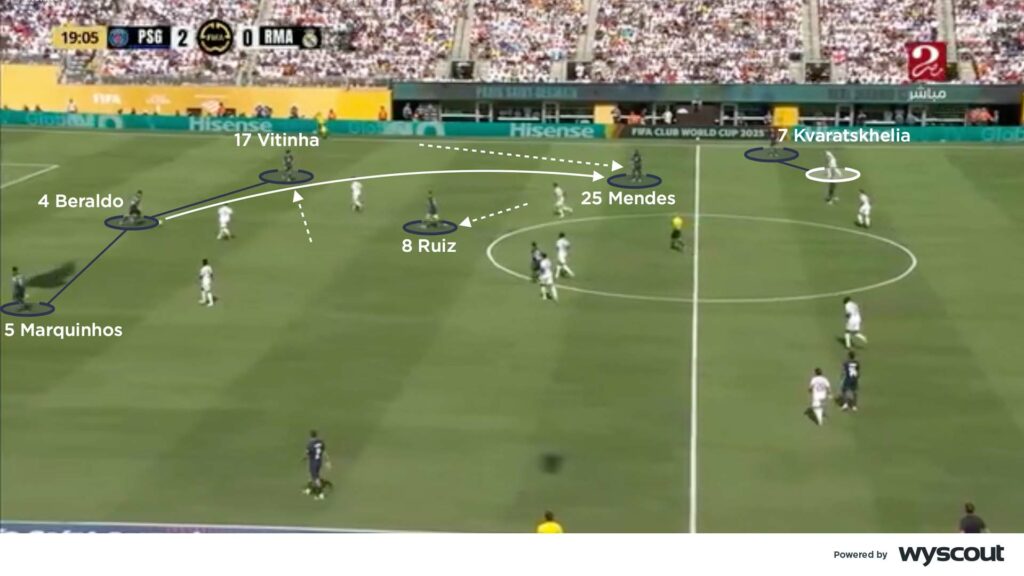
Madrid tweak the press
In the second half, Madrid committed to higher pressing, with the front three working higher and harder on to PSG’s back line. They did a much better job at forcing the ball wide as they pressed, as opposed to allowing PSG’s back line to pick out their preferred wide passes. From here, the midfield three could better predict and prepare to cover across the pitch, ready to support the wide press. When PSG switched across the back line, Madrid’s full-backs – particularly the energetic Valverde (below) – readied to jump and support alongside the central-midfield unit, so Madrid could press the eventual wide pass. The rest of the back line, particularly the closest centre-back, swung around to lock PSG to one touchline.
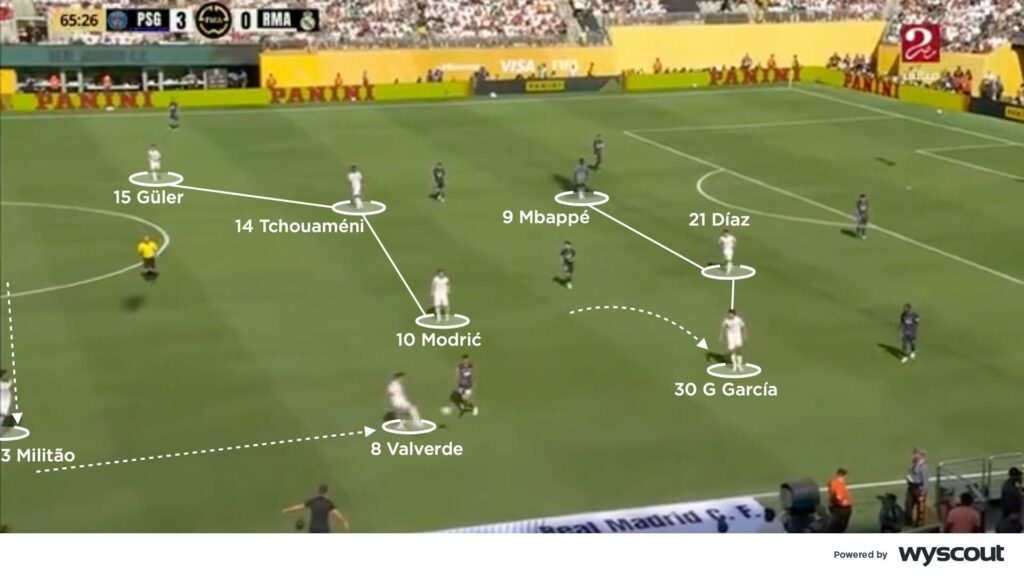
With Madrid’s front line putting more and better pressure on PSG’s build, sometimes the French side were forced to play direct to their front three. In these moments Madrid’s centre-backs aggressively followed the dropping movements of centre-forward Ramos, competing well into midfield. The back line then covered for any flick-ons or second balls, with the remaining, unattached centre-back covering just behind. Madrid’s compact midfield helped by back-pressing and supporting the defending against PSG’s more direct build, while the opposite winger also worked back and narrowed (below).
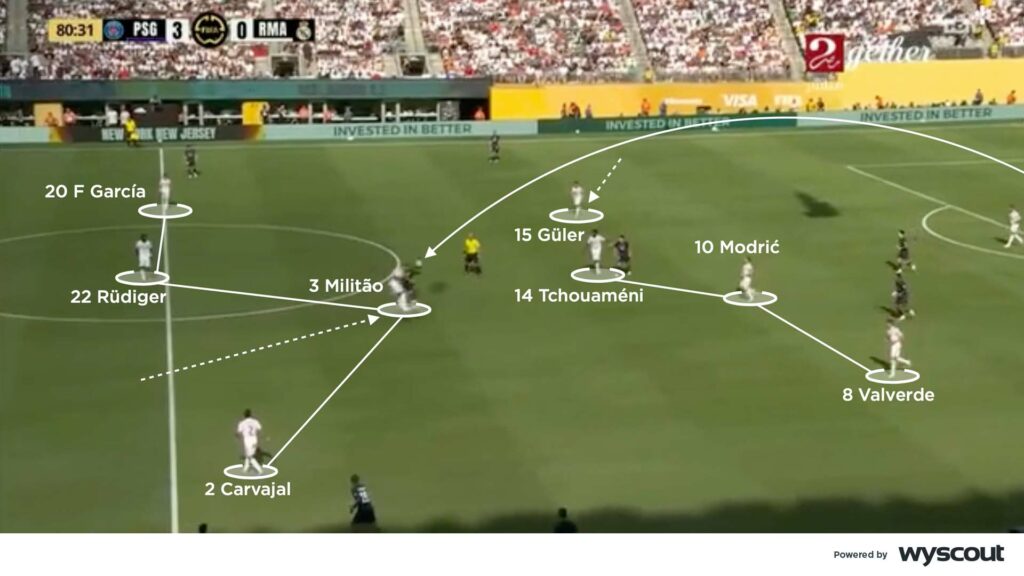
With greater defensive numbers and better positioning, Madrid established possession beyond the halfway line for longer periods in the second half, reducing the number of dangerous PSG attacks. In effect it was damage limitation, as the club that regards itself as the world’s number one faced up to a comprehensive defeat by the team that could soon be confirmed as the undisputed best.
To learn more about football tactics and gain insights from coaches at the top of the game, visit CV Academy



